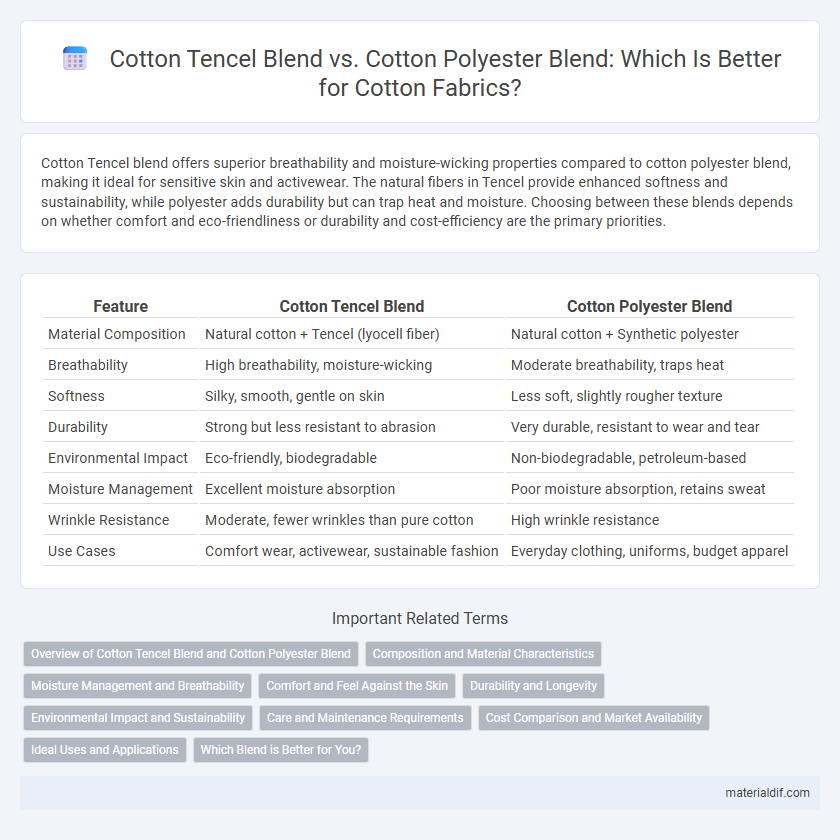Cotton Tencel blend offers superior breathability and moisture-wicking properties compared to cotton polyester blend, making it ideal for sensitive skin and activewear. The natural fibers in Tencel provide enhanced softness and sustainability, while polyester adds durability but can trap heat and moisture. Choosing between these blends depends on whether comfort and eco-friendliness or durability and cost-efficiency are the primary priorities.
Table of Comparison
| Feature | Cotton Tencel Blend | Cotton Polyester Blend |
|---|---|---|
| Material Composition | Natural cotton + Tencel (lyocell fiber) | Natural cotton + Synthetic polyester |
| Breathability | High breathability, moisture-wicking | Moderate breathability, traps heat |
| Softness | Silky, smooth, gentle on skin | Less soft, slightly rougher texture |
| Durability | Strong but less resistant to abrasion | Very durable, resistant to wear and tear |
| Environmental Impact | Eco-friendly, biodegradable | Non-biodegradable, petroleum-based |
| Moisture Management | Excellent moisture absorption | Poor moisture absorption, retains sweat |
| Wrinkle Resistance | Moderate, fewer wrinkles than pure cotton | High wrinkle resistance |
| Use Cases | Comfort wear, activewear, sustainable fashion | Everyday clothing, uniforms, budget apparel |
Overview of Cotton Tencel Blend and Cotton Polyester Blend
Cotton Tencel blend combines natural cotton fibers with Tencel, a fiber made from sustainably sourced wood pulp, resulting in a fabric known for its softness, breathability, and eco-friendly properties. Cotton Polyester blend integrates cotton with polyester fibers, enhancing durability, wrinkle resistance, and moisture-wicking capabilities while maintaining affordability. Both blends balance natural comfort with functional performance, with Cotton Tencel focusing on sustainability and softness, and Cotton Polyester emphasizing strength and ease of care.
Composition and Material Characteristics
Cotton Tencel blends combine natural cotton fibers with Tencel, a sustainable fiber derived from eucalyptus wood, resulting in a fabric that is breathable, moisture-wicking, and soft to the touch. In contrast, Cotton Polyester blends mix natural cotton with synthetic polyester fibers, enhancing durability, wrinkle resistance, and quick-drying properties while potentially sacrificing some breathability. Both blends offer unique material characteristics tailored for comfort and performance, with Cotton Tencel prioritizing eco-friendly softness and Cotton Polyester emphasizing strength and longevity.
Moisture Management and Breathability
Cotton Tencel blend fabrics offer superior moisture management and breathability compared to cotton polyester blends, as Tencel fibers absorb moisture efficiently and release it quickly, keeping the skin dry and comfortable. Cotton polyester blends tend to trap moisture due to polyester's synthetic nature, reducing airflow and breathability. This makes Cotton Tencel blends ideal for activewear and warm climates, enhancing comfort through better ventilation and moisture-wicking properties.
Comfort and Feel Against the Skin
Cotton Tencel blend offers superior softness and breathability due to Tencel's moisture-wicking and smooth fiber structure, resulting in a gentle, cool feel against the skin. Cotton Polyester blend tends to be less breathable, with polyester fibers contributing to a slightly synthetic texture and reduced moisture absorption, which can cause discomfort during extended wear. The natural feel and hypoallergenic properties of the Cotton Tencel blend make it ideal for sensitive skin and warm climates.
Durability and Longevity
Cotton Tencel blend fabrics offer superior durability due to Tencel's strong cellulose fibers, which resist wear and maintain fabric integrity over time. Cotton polyester blends are also durable, benefiting from polyester's resilience and resistance to shrinking and stretching, but may degrade faster under high heat or prolonged UV exposure. Both blends enhance longevity compared to pure cotton, with Tencel blends providing better breathability and environmental resistance, while polyester blends excel in maintaining shape and color retention.
Environmental Impact and Sustainability
Cotton Tencel blends offer superior environmental benefits due to Tencel's biodegradable properties and sustainable production from eucalyptus trees, significantly reducing water and chemical use compared to synthetic fibers. Cotton Polyester blends, while durable and cost-effective, rely on petroleum-based polyester, contributing to microplastic pollution and higher carbon emissions during production. Choosing Cotton Tencel blends supports reduced ecological footprints and promotes circular fashion initiatives.
Care and Maintenance Requirements
Cotton Tencel blends require delicate care, often needing cold water washing and air drying to maintain fabric softness and reduce shrinkage. Cotton Polyester blends are more durable and wrinkle-resistant, allowing for machine washing in warm water and tumble drying with minimal risk of damage. Both blends benefit from avoiding high heat ironing to preserve fiber integrity and extend garment lifespan.
Cost Comparison and Market Availability
Cotton Tencel blend fabrics generally come at a higher price point than cotton polyester blends due to the sustainable production process and premium quality of Tencel fibers. Cotton polyester blends dominate the market with wider availability and cost-effectiveness, making them a preferred choice for budget-conscious consumers and mass production. The market demand for eco-friendly textiles, however, is steadily increasing the presence of cotton Tencel blends despite their higher cost.
Ideal Uses and Applications
Cotton Tencel blend fabric offers superior moisture-wicking and breathability, making it ideal for activewear, casual wear, and sustainable fashion collections where comfort and eco-friendliness are prioritized. Cotton Polyester blends excel in durability, wrinkle resistance, and affordability, suited for uniforms, workwear, and everyday clothing requiring easy maintenance and long-lasting performance. Choosing between these blends depends on the balance between environmental impact, tactile comfort, and garment longevity needed for specific applications.
Which Blend is Better for You?
Cotton Tencel blend offers superior breathability and moisture-wicking properties, making it ideal for sensitive skin and hot climates. Cotton Polyester blend provides enhanced durability and wrinkle resistance, suitable for active lifestyles and easy maintenance. Choosing the right blend depends on your preference for comfort and eco-friendliness versus practicality and longevity.
Cotton Tencel Blend vs Cotton Polyester Blend Infographic

 materialdif.com
materialdif.com